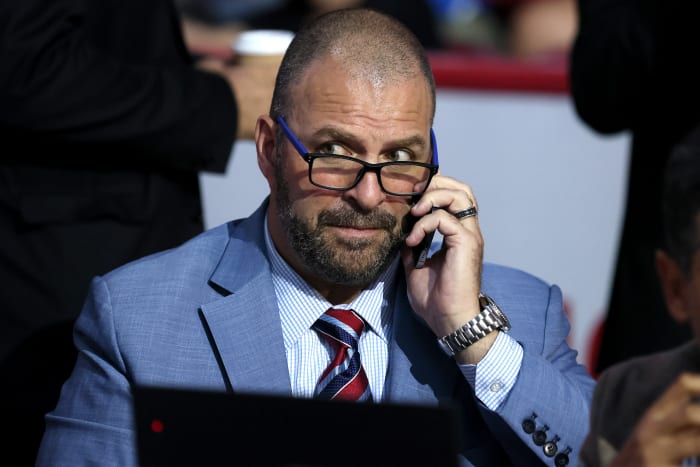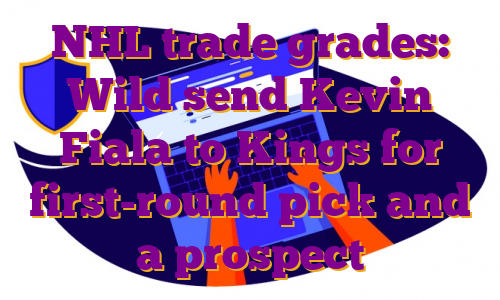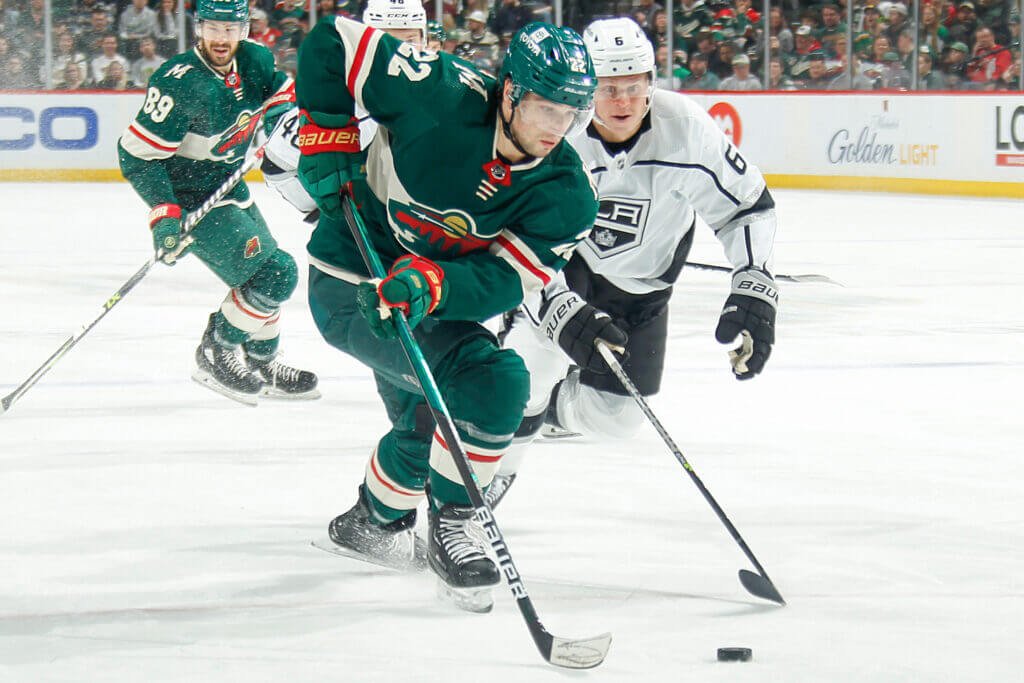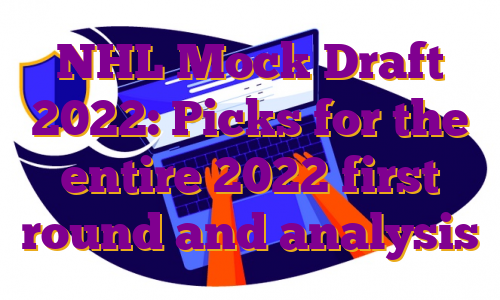Welcome to my mock of the 2022 NHL Draft’s first round.
After completing my own draft work for this year’s class, I’ve spent recent weeks considering targets for each team and asking around about potential fits as the draft order has taken shape.
This piece is a pivot away from the work that goes into building my own draft board. Instead of being a reflection of the players I would choose at each slot, it attempts to match my sense for the consensus about these players with the information I’ve gathered about specific interest in them, team needs and my understanding of each club’s amateur scouting preferences.
It’s meant to be my best guess for how things will play out. I’ve also mapped out contingencies and other likely considerations listed wherever relevant (and wherever I feel comfortable enough to hypothesize).
For my evaluations of these players, check out my final top 100 ranking for 2022.
1. Montreal Canadiens: Shane Wright, C, Kingston Frontenacs
My rank: No. 1
I don’t think this is a sure thing, but I still think it’s far and away the most likely thing. Even as the consensus around Wright as the No. 1 player in the draft has shrunk and both Juraj Slafkovsky and Logan Cooley have entered into the conversation, it’s not as though that consensus has disappeared. Wright is still the No. 1 guy in a survey of scouts. He’s still a strong fit as the potential second top-six centre that they both covet and need behind Nick Suzuki. While they won’t admit publicly that the draft being in Montreal adds a layer to the selection, and probably wouldn’t even admit it internally or to themselves in the name of we-just-have-to-pick-the-best-player, I think it does matter, at the very least subconsciously, that he’s the biggest name and any other will take the air out of the building. I also think there’s something to be said for his likelihood of panning out vis-a-vis the other kids. There may well be another player or two in the draft who challenge him — or maybe even surpass him — as the class’s best, but there probably isn’t one who stands a greater chance of being a top-five guy in it. And because of his position, they likely won’t regret it even if that’s how it plays out.
Is Shane Wright worthy of the Canadiens’ No. 1 pick in the 2022 NHL Draft?@ArponBasu watches 15 of Wright’s final games this season with the Kingston Frontenacs to try to understand why his draft stock is slipping ⤵️https://t.co/8gtuUoGN5o
— The Athletic NHL (@TheAthleticNHL) May 20, 2022
2. New Jersey Devils: Juraj Slafkovsky, LW, TPS
My rank: No. 5
With centres Jack Hughes, Nico Hischier and Dawson Mercer all entering or approaching the prime of their careers, and after having drafted a star D prospect in Luke Hughes a year ago, the Devils are in a rare situation where they don’t have to worry about drafting for a premium position. Mix in the belief, held by many, that the Devils need to get bigger (which, I should note, doesn’t stack up with their average height or weight, both of which were in the league’s top 10 last year), and some questions about whether Alexander Holtz will land closer to a 25-goal guy than a 35-plus-goal guy, and the readymade quality of Slafkovsky’s game that won’t require years of waiting for, and he just makes a lot of practical and theoretical sense.
3. Arizona Coyotes: Logan Cooley, C, U.S. NTDP
My rank: No. 3
The Coyotes’ four centres in the last game of the season were Barrett Hayton, who has scored 13 NHL goals, a pair of college free-agent signings (Jack McBain and Nathan Smith), and Alex Galchenyuk, a pending unrestricted free agent on his second stint with the Coyotes after playing for four other teams in between. They’ve got some real pieces to work with on the wing. Clayton Keller. Nick Schmaltz. Jan Jenik. Soon, Dylan Guenther. But those guys need someone to play with down the middle badly. Cooley fits the bill perfectly as a high-skill, high-energy, high-speed go-getter and creator who would fit stylistically really quite well alongside a Keller or a Guenther (similarly to how Schmaltz does). I’d bet that even if Slafkovsky were available, they’d still take Cooley.
4. Seattle Kraken: Simon Nemec, RHD, HK Nitra
My rank: No. 2
I think it’s safe to say that the Kraken will select one of the two-top defencemen in the draft, after having selected centre Matty Beniers second last year. While the book is still very much out on their amateur scouting philosophy (they drafted older last year, presumably as a means to an end for their new AHL team’s purposes in Palm Springs), the sense I get is that they want to build a progressive team (and franchise) in a variety of ways, and the subtleties of the way Nemec plays the game fit that kind of belief system more than David Jiricek’s outwardly visible and straightforward style that teams have long coveted (and still do). The Nemecs of the world are the future of the position. He’s a modern defenceman and more and more players who play like him are both entering the league and changing what we want defenders to do. If Jiricek is closer to the Aaron Ekblads and Moritz Seiders of the world, Nemec is akin to what guys like Adam Fox and Devon Toews (not necessarily in skill but in approach) now mean to the game in a very different mould. I get the sense the Kraken are drawn to the latter.
5. Philadelphia Flyers: David Jiricek, RHD, HC Plzen
My rank: No. 6
I’ve now had two people tell me to keep an eye on the Flyers steering the draft down an unexpected path at No. 5. There has been some chatter about them and NTDP forward Cutter Gauthier, an athletic, goal-scoring forward who plays a bit of a power forward 2.0 game and played mostly the wing at the national program but will play centre at Boston College and could fill a size-skill-scoring need for the Flyers down the middle. Still, if the Kraken take Nemec and Jiricek is available, I’d guess he’s the favourite for the Flyers’ pick as the big, strong, commanding rearguard they covet. He’s a very Flyers player. If Jiricek is gone, though, that’s probably more likely where someone like Gauthier comes into play.
6. Columbus Blue Jackets (from Chicago): Cutter Gauthier, C/LW, U.S. NTDP
My rank: No. 18
If the Flyers take Gauthier and one of the two top D are available at this slot, I get the sense the Blue Jackets would be eager to take either of them (based on their preferences, I’d guess they really like Jiricek). If both are gone, though, and the Flyers don’t go off the board, this is where things will likely start to break open in the draft. Because if a forward is the choice, the Blue Jackets haven’t really revealed themselves to have a type in the way that some other teams (including the next in the draft order here) have. The good news is they’re likely after more of a finisher than a facilitator and there are four of them to pick from. They’ve got some Gauthier types in their pool and/or roster in guys like Yegor Chinakhov, Kirill Marchenko and Dmitri Voronkov. But they also took a swing on Kent Johnson and his more perimeter playmaking-skill game last year, and a guy like Jonathan Lekkerimaki would represent a similar cut and a potentially excellent fit as a triggerman for Johnson long term. If they’re looking for a little more speed, Matthew Savoie would make sense. I wouldn’t rule out Jarmo Kekäläinen taking Finnish sniper Joakim Kemell here either. Savoie and Gauthier bring a little more versatility than Lekkerimaki and Kemell, in that they can play the wing or centre — they also offer physicality and tenaciousness that Lekkerimaki can lack. I’ll give the slight edge to the potential centres — and to Gauthier’s rising stock specifically (enthusiasm about Savoie softened ever so slightly late in the year and then he suffered a shoulder injury to end it on a bit of a sour note).
7. Ottawa Senators: Joakim Kemell, RW, JYP
My rank: No. 7
I’ve had a tough time handicapping the Sens in recent drafts because they’ve made a habit of going off the board and walking to the beat of their own drum, but there’s no question they have a type: the hard-working, engaged, 200-foot, athletic player. I’ve also said for years that they need one more high-skill forward who can move the needle if they want to take their strong group of lunch pale types and elevate beyond that. Brady Tkachuk, Josh Norris and Drake Batherson are stars but they’re not superstars and Tim Stützle’s on the cusp of stardom but probably won’t be one either. You’re likely getting a fifth guy of that calibre here. Can you win a Cup without one of the game’s 10 best forwards on your roster long term? Maybe not. But another player who can be more of a one-punch game breaker would be huge. Stützle has some of that in him, but Tkachuk, Batherson and Norris do most of their damage over the course of a game rather than in a brilliant moment (though Norris’ shot can open up a game). Here, the Sens have an opportunity to add a player who fits their type and has that dynamic quality they need in the noticeable, active, individual creation games of Matthew Savoie and Joakim Kemell. I’m pretty confident it will be one of the two if Gauthier is gone.
8. Detroit Red Wings: Matthew Savoie, C/RW, Winnipeg Ice
My rank: No. 4
It’s hard to deny the obvious connections and clear tendencies that make Rögle forward Marco Kasper an option here for the Red Wings. But even after a strong playoff performance gave him greater consideration in this kind of range, and even with the ties, I’ve still had multiple folks in the sport tell me that this is a little early for him. If there’s a strong voice in the Red Wings amateur scouting group who agrees, I think Savoie makes the most positional and stylistic sense. I like him better as a centre than winger and I know some teams agree, even if there’s a divide on that topic (there’s also a divide on whether Kasper will be a centre and he played the wing exclusively this season). The Red Wings both like the skill guys with motors and need more of them.
9. Buffalo Sabres: Jonathan Lekkerimaki, RW, Djurgårdens IF
My rank: No. 9
Of the trio of 5-foot-9/10 forwards projected to go in the No. 5-10 range, Lekkerimaki feels like the most likely to be selected third even after his star grew following his brilliant U18 worlds performance. The Sabres should take whichever remains at No. 9 and while I suspect they’re more likely to take the potential centre in Savoie if he’s here (they’ve got plenty of talented wingers in their pool), I think they’re more likely to pounce on Lekkerimaki as the best player available (BPA) play, hoping that they can get one of the next-best centres (like a Frank Nazar or a Conor Geekie) with their next selection at No. 16.
10. Anaheim Ducks: Kevin Korchinski, LHD, Seattle Thunderbirds
My rank: No. 17
I’ve been told by a couple of scouts that mock drafts too often let defencemen slide and to look out for there to be three defencemen taken in the top-10 in this year’s draft (as there usually are). If this year were ordered in a myriad of other ways, that third guy would be Denton Mateychuk for multiple teams. But because the Ducks already have the 5-foot-11 Jamie Drysdale and have likely pencilled the 5-foot-9 Olen Zellweger into the second of their top-six jobs of the future, I’d bet they target the long, smooth mobility of Korchinski sooner than another 5-foot-11 type like Mateychuk (as great as Mateychuk is on both sides of the puck).
11. San Jose Sharks: Denton Mateychuk, LHD, Moose Jaw Warriors
My rank: No. 13
The Sharks have drafted a lot of smallish forwards who can play in possession and manufacture offence in recent years and the result has been twofold:
- Their pool has improved, most of those kids have shown real promise, and now they’ll begin to compete with each other for NHL jobs in the next couple of years.
- They don’t have much coming on defence behind Ryan Merkley who, even with some strong play in stretches this season, still has some question marks about his ultimate NHL upside.
The expectation among those I’ve talked to is that the Sharks will likely take a defenceman here for those reasons. That makes Mateychuk or Russian OHL star Pavel Mintyukov the probable choices (with Korchinski in the mix if he’s available, too).
12. Columbus Blue Jackets: Pavel Mintyukov, LHD, Saginaw Spirit
My rank: No. 25
If the Blue Jackets take one of the D at No. 6, then I’d zero in on big centre Conor Geekie and top Russian prospect Danila Yurov as the most likely choices here (I could see the Blue Jackets, with their bevy of Russian kids and multiple first-round picks for the second year in a row, being the team to take a chance on Yurov and hope to get him over here sooner rather than later). But if it’s Gauthier or another forward like I have it playing out here, I think the three D discussed in this range become the play. Mintyukov and his bold “I can do everything I want” (he literally said that at the combine) game remains, so he’s the guy in this scenario I’d think. They aren’t shy to take swings on players in Columbus either, and Mintyukov would both represent that and has some big believers. So too would hulking defenceman Lian Bichsel, who interviewed with all 32 teams at the combine and is expected to go in the middle of the first round somewhere.
13. New York Islanders: Conor Geekie, C, Winnipeg Ice
My rank: No. 16
Geekie just feels like a Lou Lamoriello pick. I think there’s a chance he goes a slot or two higher than this because of the desirability of a big centre who can handle, hold and facilitate with the puck (as well as shoot it). There really isn’t much in the Islanders’ pool on the blue line after they graduated Noah Dobson and Robin Salo, so I’d count on the defencemen taken directly in front of them here being in the mix if they’re available as well, but their system is a bit of a wasteland at every position and Geekie is still considered a premium prospect at a premium position by many in the sport.
14. Winnipeg Jets: Marco Kasper, C/RW, Rögle BK
My rank: No. 24
If the Red Wings don’t take Kasper, I think the teens are the range he’s more likely to be picked in. While I suspect the Jets would be keen to take a defenceman here after selecting forwards with their last four picks in the draft’s first two rounds, if the bigger names are gone (I think Mintyukov is the most likely of the three D taken in the 10-12 range here to be available), Kasper begins to make a lot of sense as a well-rounded complement to the thinking/finesse game of Cole Perfetti and the scorer’s game of Chaz Lucius. If one of Kasper and Lucius can stick at centre, that’d be big for them long term. If both do, they’ve really solidified their depth (with two very different players).
Marco Kasper spoke with 30 teams this week. Makes me tired just thinking about it when you hear about a guy going through that many. Only teams he didn’t talk to: Dallas and Carolina.
— Scott Wheeler (@scottcwheeler) June 4, 2022
15. Vancouver Canucks: Liam Öhgren, LW, Djurgårdens IF
My rank: No. 14
The Canucks just need good players to inject into their dwindling pool, and they need them at all positions. I like Öhgren as, ironically enough because of his uncertain future and RFA status, a Brock Boeser type. He’s also a player that I’d bet the changing front-office group with the Canucks would covet, not just because of his high-end production this year but because of the projectability of his game as a physically mature skill-sturdiness combination winger with quick hands, a powerful shot and a well-respected approach to the game/leadership. He’s only got one year left on his contract with Djurgårdens and I expect him to do some damage in a more prominent role after their demotion to the second-tier HockeyAllsvenskan. I wouldn’t be surprised if he came over here after that and if his game was an even better fit on North American ice than Sweden’s international sheets.
16. Buffalo Sabres (from Vegas): Frank Nazar, C, U.S. NTDP
My rank: No. 11
If the Sabres take a winger at No. 9, look to them to take a centre here. I’ve gone with Nazar, who is not as beloved in the private sphere as he is publicly, but offers speed and playmaking that the Sabres can afford to wait for if he takes two or three years in college. This is also the range where centres Jiri Kulich and Noah Ostlund will start to creep toward the top of boards so they’d make sense here. I wouldn’t be surprised if the Sabres, with their strong pool and multiple high picks, took a swing on Lambert or Yurov here either (though Yurov is strictly a winger so the likelihood that they take him drops if they take a winger with the first pick).
17. Nashville Predators: Lian Bichsel, LHD, Leksands IF
My rank: No. 51
Even after suffering a concussion and missing much of the last couple months of the season (including U18 worlds, where he was supposed to captain the Swiss), the 6-foot-5 Bichsel is expected to be picked in the first round of the draft. He’s one of a small group of players who interviewed with all 32 clubs at the combine, and his hulking, physical, and yet oddly mobile and poised style has drawn a lot of interest. The Preds, who have a track record of developing big defencemen and have spent all of their recent high picks on forwards (Fyodor Svechkov, Zachary L’Heureux, Luke Evangelista, Philip Tomasino, Egor Afanasyev, etc.) and a goalie (Iaroslav Askarov), feel like his most likely landing spot.
18. Dallas Stars: Ryan Chesley, RHD, U.S. NTDP
My rank: No. 30
After following up 2020’s first-round selection of forward Mavrik Bourque by using their first two picks of the 2021 draft to make contact (and maybe even smack them both out of the park for a pair of home runs) on Wyatt Johnston and Logan Stankoven, the Stars are yet another team that looks poised to take a defenceman this time around. I also expect first-pairing NTDP defenceman and the University of Minnesota commit Ryan Chesley, who is almost unanimously well-liked among NHL scouts and has been a name prospect for years, to go higher than where most in the public sphere have him.
19. Los Angeles Kings: Brad Lambert, C/RW, Pelicans
My rank: No. 8
There is no prospect pool in the sport that is as crowded as the Kings’ is and it’s entering a phase in the next couple of years where there aren’t going to be enough jobs to fulfil the demands of promotions out of the pool, leaving deserving prospects out of the NHL and likely necessitating trades. That puts them in the perfect position to take a cut on a player. They don’t have to worry about readiness. They don’t have to worry about positional need. They just get to take a swing. They haven’t shied away from taking cuts on polarizing prospects in the past, either. If I’m a member of the Kings’ staff, my list starts and ends with Lambert, Yurov and Ivan Miroshnichenko here, with the Finn as the more likely pick over the Russians given the uncertainty around Yurov getting over here and Miroshnichenko’s health.
20. Washington Capitals: Jiri Kulich, C/LW/RW, HC Energie Karlovy Vary
My rank: No. 22
The Capitals used recent top picks on forwards when they drafted Connor McMichael and Hendrix Lapierre, so I almost took a D here. But the big names are gone, this feels a little early to take one of the defenders from the next group, and Kulich is exactly the kind of player their group typically covets. He’s a driven, pro-sized forward with a defining trait (his shot and specifically his one-timer). He’s also projected to go in the 20s now and I expect his experience against professionals and his positional versatility (he has played all three forward positions for extended stretches either domestically or internationally) push him to the front of the 20s. If the Capitals go D here, this may be the earliest the long, smooth-skating Owen Pickering could go (Pickering is cast a lot like Capitals 2021 pick Vincent Iorio, too).
21. Pittsburgh Penguins: Rutger McGroarty, LW, U.S. NTDP
My rank: No. 15
The Penguins’ prospect pool is, has been, and will continue to be one of the weakest in the league regardless of what the Penguins do with this pick. They’ve got holes at LHD, RHD, C, RW and LW. That they’ve held onto this pick speaks to their desire to enter this next chapter with their core with one eye on the future instead of both closed. It’s also incumbent on them that they hit, though. They’ve got to make sure they have something coming. There are two kids that scream Ron Hextall/Brian Burke types that I’d look to specifically in McGroarty, the NTDP’s captain, who is already built like an NHL player and oozes charism and character (I suspect he left a strong impression on a lot of folks in his combine interviews and I’d bet that includes the Penguins), and Nathan Gaucher, another athletically-advanced player who is a better skater than McGroarty and projects as a driven third-liner with size and presence that complement good skill.
22. Anaheim Ducks (from Boston): Isaac Howard, LW, U.S. NTDP
My rank: No. 10
The Ducks have their centres of the future in Mason McTavish and Trevor Zegras. If they take a D at No. 10 and add them to Drysdale, Zellweger and co. they’ll be in a really good spot there too. So a scoring winger makes a lot of sense and Howard, one of the most talented players and slot finishers in the draft, fits the bill. The Ducks take the program’s leading scorer for the second year in a row, a year after drafting Sasha Pastujov in the third round when he fell.
23. St. Louis Blues: Owen Pickering, LHD, Swift Current Broncos
My rank: No. 53
The Blues have used their six highest picks of the last four drafts on forwards and could now really use a top prospect on the back end to take the mantle as the organization’s No. 1 D in the pool from soon-to-be-graduate Scott Perunovich. They won a Stanley Cup with a big, long D core that could skate and that’s Pickering, who is well-liked as a kid and has come along fast as a player, shooting up through a growth spurt and impressing scouts all year long with his length and mobility — and then the way he carried and presented himself in interviews at the combine.
24. Minnesota Wild: Danila Yurov, LW/RW, Metallurg Magnitogorsk
My rank: No. 12
The Wild, like the Ducks’ two picks in front of them, have a strong pool at C, D and G now, and are one of the teams in the best position to take a winger as a result. Because they’ve got one of the better pools in the league, on the whole, they can also afford to take a cut and take a bit of a chance. Yurov, a top-10 pick if all things were equal with the Russians (the reality is that they’re not at the moment) is the clear best player available, can play both wings, and could be a home run if they can get him over here. This is about where the gap between him and his available peers becomes wide enough that you take the chance. The Wild should if he’s there. I’d consider Howard in their shoes if he’s around, too.
25. Toronto Maple Leafs: Noah Ostlund, C, Djurgårdens IF
My rank: No. 23
There are three players that scream Leafs selections in this range: Howard, who is gone here, Swedish centre Noah Ostlund, and Moose Jaw’s Jagger Firkus. Firkus is a slight but thrilling offensive player who threatens every time he touches the puck (the last time the Leafs drafted a player from the Warriors, it worked out well for them when he became their No. 1 defenceman!). Ostlund is a slight, slick, playmaking, smooth-skating centre with a trusted defensive game. Both possess the puck, problem solve, and play the hard-working off-puck game that the Leafs like. In a consensus poll, though, Ostlund probably ranks higher (even after Firkus’ surge in the second half) and is the slightly more likely pick if he’s available.
26. Montreal Canadiens (from Calgary): Nathan Gaucher, C, Quebec Remparts
My rank: No. 38
Teams rebuild through the middle of the ice and the Canadiens adding Wright as a top-six centre of the future with Suzuki, and Gaucher as a potential third-line centre of the future to play behind them would certainly set them off on the right foot. No matter what they say, it probably doesn’t hurt that he’s French-speaking and from just outside of Montreal for a draft held in Montreal, either.
Nathan Gaucher showing us why he’s highly touted for the 2022 #NHLDraft@quebec_remparts | @QMJHL pic.twitter.com/ibhnpLgaxh
— Canadian Hockey League (@CHLHockey) October 28, 2021
27. Arizona Coyotes (from Carolina): Filip Mesar, LW/RW, HK Poprad
My rank: No. 21
Mesar told a small group of reporters at the combine that he felt like the Coyotes and Lightning were the most interested in him. It’s pretty rare for a prospect to come right out and say something like that, but it’s fascinating when it happens because those teams now have information about one another. Before I learned that, Mesar was being talked about as a 30s guy who was likely going to be picked with one of the last three or so picks of Day 1, or the first few picks of Day 2. Ironically, the Coyotes and Lightning are also going to hold two of those last picks of the first round. As I write this, there are just three slots left to be determined by the last three remaining teams. They are the Lightning’s own pick, the Avalanche’s pick (held by the Coyotes!) and the Rangers’ pick (held by the Jets), and they can still all land in any order between 30-32. If the Avalanche were to win the Cup and Arizona’s third pick of the first round became the 32nd selection, I now wonder if the Coyotes would pick Mesar (if indeed he’s their guy) here in order to avoid the Lightning getting a crack at him before their next shot. I expect the Coyotes will take two forwards and one defenceman, and the D that are available here will still likely be around a few picks from now, so it would make some sense.
28. Buffalo Sabres (from Florida): Jagger Firkus, RW, Moose Jaw Warriors
My rank: No. 34
I didn’t think when I began this exercise, that I’d have the Sabres taking three forwards. I think it’s more likely they take two forwards and one defenceman. But with the way things played out here and the number of teams that I suspect will be eager to take defencemen, I actually really like the way things broke for the Sabres in this exercise. Lekkerimaki, Nazar and Firkus would be a substantial injection of skill into the organization; drafting all three would make for a potentially huge day for the organization’s future. Teams will tell you they try not to be influenced in their decision-making by the number of picks that they have, but the truth is that the first two do allow the Sabres to really go after a high-upside kid here and there may not be a bigger one left than the diminutive but uber-talented Firkus.
29. Edmonton Oilers: Jack Hughes, C, Northeastern University
My rank: No. 29
The Oilers went the college route with Dylan Holloway in 2020 — that pick has looked good thus far — and I wouldn’t be surprised if they go back to the well and take Hughes here. Most teams have him in the second round but a standout performance at the combine (both in the testing where he was one of the highest achievers and in the interviews according to a couple of sources) could sneak him into the first. Look for his production to take a strong uptick as a sophomore at Northeastern next year.
30. Winnipeg Jets (from the Rangers): Tristan Luneau, RHD, Gatineau Olympiques
My rank: No. 31
If the Jets take a forward with their first pick, look for them to take a defenceman with their second in order to insulate the pool behind Ville Heinola. The 30s are also where Luneau — the intelligent, workhorse former No. 1 pick of the Gatineau Olympiques — is most likely going to land. A knee injury cost him his summer and the start of his draft year, but once he got back and healthy, he was a dominant two-way defender in the QMJHL and played his best hockey of the year logging huge minutes in the playoffs. He’s not going to be a star but projects as a second-pairing guy.
31. Tampa Bay Lightning: Ivan Miroshnichenko, LW/RW, Omskie Krylia
My rank: No. 28
It’s no secret the Lightning’s pool is feeling the effects of its two Stanley Cups but their continued contender status allows them to play the long game with the kids that they do have (or might pick), which makes taking a chance on Miroshnichenko, a top-10 pick in the draft before his Hodgkins lymphoma diagnosis, a worthwhile gamble for them. They drafted a certain star Russian winger in the second round a little more than a decade ago. While Miroshnichenko’s not going to be Nikita Kucherov, he’s a much better prospect (health permitting) than where he’ll be picked and he wants to come to North America sooner rather than later (like Kucherov did when he went to the QMJHL a year after the Lightning selected him).
32. Arizona Coyotes (from Colorado): Jimmy Snuggerud, RW, U.S. NTDP
My rank: No. 26
It would be a little ironic for the Coyotes to draft two-thirds of the NTDP’s first line and not take the one kid (Gauthier) who is actually from Arizona. But Snuggerud, a strong, well-rounded winger who can do a little bit of everything offensively and projects as a solid NHL player if he can get a step quicker, makes a lot of sense — not just in this range but for the Coyotes if they draft Cooley and want to surround him with a familiar face at a minimum and a maybe a linemate who he already has chemistry with in a best-case outcome.
Best player available on Day 2: Lane Hutson, LHD, U.S. NTDP
My rank: No. 19
Here’s the thing about Hutson: In conversations with NHL folks about him, several believe he’s a first-round pick. But here’s the other thing about Hutson: There was just always a player at each slot that I felt that team would be more likely to pick. I wonder if when push comes to shove the teams that are selecting will shy away from him as a result. I also wonder if the teams that do really like him think there aren’t many who share their belief and decide to try to test the odds and see if they can wait until Day 2 to grab him. I think there are definitely a few teams that are more inclined to take a player like Hutson than others, and others that I know wouldn’t touch him. The Hurricanes, Kings and Leafs feel like the most likely of those teams to take him. But the Hurricanes don’t have a first-rounder, I don’t think the Kings will take him as early as No. 19, and there are several other players the Leafs will likely like at No. 25. Teams with multiple picks, like the Sabres and Coyotes, might make sense too, with the former being more likely due to the pre-established strength of their pool and the risk-taking it may encourage. In any event, if he’s available into the second round, I wouldn’t hesitate in taking him.
(Illustration: John Bradford / The Athletic; Photos: Chris Tanouye, Codie McLachlan / Getty Russel Hons / AP)
.









